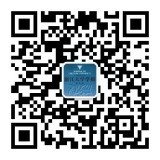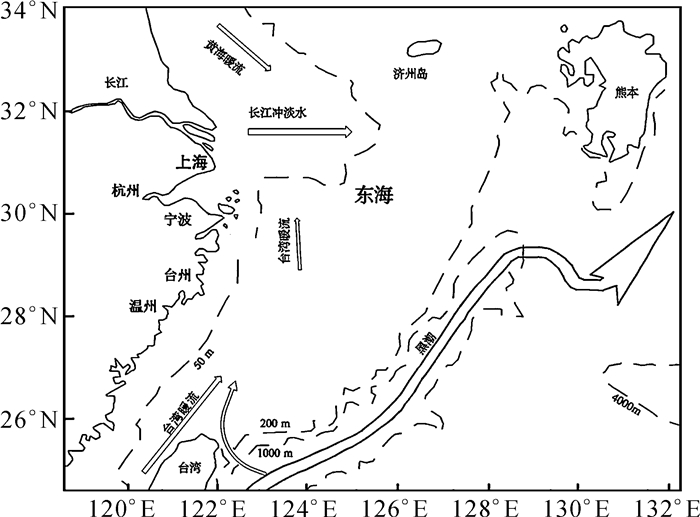2. 浙江大学 地球科学学院, 浙江 杭州 310027
2. School of Earth Science, Zhejiang University, Hangzhou 310027, China
根据中国海洋灾害公报,近几十年东海赤潮频发.第1次东海赤潮事件的发生在1933年[1].因赤潮经常大面积发生,很多学者提出利用卫星来监测赤潮,主要分为3类:第1类是通过其他参数来判别赤潮(如叶绿素含量,温度等)[2-4];第2类是通过赤潮显著的光谱特性进行监测, 如在绿光波段(550 nm)附近呈现高反射[5-8];第3类是通过藻类的荧光性对赤潮进行监测,例如有些藻类在红光波段出现荧光性[9-11].
目前,学者根据赤潮的种类已开发出不同的算法.例如LOU等[6]利用Geostationary Ocean Color Imager(GOCI)监测到东海发生大面积的原甲藻.CHOI等[3]利用GOCI监测到发生在韩国的有毒的多环旋沟藻.SISWANTO等[5]利用Moderate resolution imaging spectror adiometer(MODIS)的归一化的离水辐射率对日本区域的赤潮进行简单的分类,并将MODIS-Normalized water leaving radiance(nLw)547 nm的峰值作为判别赤潮与非赤潮的首个阀值.而TAO等[7]将MODIS—Remote Sensing reflectance(Rrs)(555 nm)作为峰值.他们都是利用赤潮在绿光波段附近的强反射性质[12]进行初步判断.然而沿岸的高悬浮泥沙和高黄色物质水体,同样具有绿光波段的高反射性质.为避免误判,TAO等[12]加入Rrs(555 nm<0.014 sr-1)这一条件进行区分,SISWANTO等[5]则利用nLw(412,443,488,547 nm)等差值比进行判别.
目前,GOCI传感器没有统一的跨时空且有效的赤潮算法,都是针对单次赤潮事件的报道.因此,尽快开发一种适用于GOCI传感器的赤潮算法很有必要.本研究利用Quick Atmospheric Correction(QUAC)大气校正法对GOCI进行校正,获取归一化离水辐射率,选用GOCI-nLw(555 nm)小于1.5 mW·cm-2·sr-1·μm-1这一阀值对中国东海赤潮进行判别.处理555 nm处的归一化离水辐射率的算法以获取3次赤潮的信息.结合MODIS和Advanced Very High Resolution Radiometer(AVHRR)等海洋传感器提供的海洋表面温度、潮位以及太阳辐照度等参数,对发生于2014年5月23日的赤潮进行详细分析,以为今后利用GOCI监测赤潮提供一条相对有效的途径.
1 研究区域东海为处于浙江省以及长江三角洲经济发达地区的海域.长江口以及浙江省沿岸和台湾暖流(见图 1)带来大量的营养物质,据国家海洋局2010~2014年的中国海洋灾害公报(http://www.soa.gov-cn/zwgk/hygb/zghyzhgb), 东海区域在每年的5~8月易暴发赤潮[13].而在长江口区域,5月份发生次数占了51% [13].DAI等[14]指出东海原甲藻可能是由台湾暖流带来的.实际上,黑潮的次表层水会携裹高NO3-/(NH4++DON)和DIP/DOP的营养物质,对东海富营养化起到一定的作用(见图 1).而在冬季,西伯利亚的北风带来富含铁和磷等元素的颗粒物也有可能导致来年春夏季东海大面积赤潮的暴发[15].
2 数据和方法 2.1 GOCI数据GOCI L1B数据从韩国海洋卫星中心(KOSC)获取(http://kosc.kordi.re.kr).首先采用韩国海洋卫星中心提供的软件GOCI Data Progressing Software(GDPS)[18]将GOCI数据转化成ENVI(ITT Visual Information Solutions公司,5.0) 能识别的img数据,然后在ENVI环境下采用QUAC对GOCI的img数据进行大气校正[19-20],得到水体反射率ρw.在海洋遥感中,ρw=ρsuf [21],又因为Rrs≈ρw/π(忽略臭氧和水汽等气体气溶胶光学厚度,τ为0).因此,归一化离水辐射度(nLw)可按照以下公式计算:
| $ {\rm{nLw}} = {\rho _{\rm{w}}} \times {F_0}\left( \lambda \right)/{\rm{\pi }}, $ |
其中,F0(λ)为各个GOCI的各波段大气层外的平均太阳辐照度(见表 1).其值为太阳位于天顶处消除大气的影响后光离开海面的辐射度.它携带海面的信息,对赤潮信息的提取起关键作用[5].
| 表 1 GOCI各波段大气层外的平均太阳辐照度 Table 1 The extra-terrestrial solar irradiance ofGOCI in band |
研究将获取的GOCI-nLw(555 nm)作为赤潮特征值,进而获取3次赤潮信息.首先,从GOCI传感器获得2011年5月29日04:28(UTC)东海原甲藻事件发生时的真彩色图像(见图 2).

|
图 2 2011年5月29日04:28(UTC)的真彩色图 Fig. 2 The ture color image at 04:28(UTC)May 29, 2011 红色部分代表进行归一化离水辐射率提取. Red part present obtained normalized water leaving radiance. |
在红色十字架部分选取各个波段的nLw,在不同经纬度上呈现差异(见图 3).结合真彩色图像,发现赤潮区域是nLw(555 nm)小于1.5 mW·cm-2·sr-1·μm-1且大于各个波段nLw值的区域.因此,本次研究选择nLw(555 nm)小于1.5 mW·cm-2·sr-1·μm-1来区分正常水体与赤潮水体.最后,采用本次研究所得到的归一化离水辐射率参数,对2011~2014年东海赤潮进行追踪.继而监测到2011年7月中肋骨条藻和2014年5月东海原甲藻2次赤潮事件.

|
图 3 不同经纬度的归一化离水辐射率 Fig. 3 The nLw on different latitudes and longitudes 数据来自图 2的红色十字. Data are from the red transect in fig. 2. |
研究采用的有效光合辐射数据(PAR)获取于Aerosol Robotic Network (AERONET)的Lulin站位(http://aeronet.gsfc.nasa.gov/).从每小时的第1~59 min,计算小时平均PAR值以分析赤潮.假设该海域的透明度为2 m[22-23],则水下光照强度与深度的关系为
| $ {I_{{\rm{PAR}}}}\left( z \right) = {I_{{\rm{PAR}}}}\left( 0 \right) \times {\rm{EXP}}\left( { - 1.51 \times Z/{\rm{SSD}}} \right), $ |
其中,IPAR(z)为有效光合作用强度在深度为Z处的值,IPAR(0) 为海面的有效光合作用强度(这里使用Lulin站的PAR产品),Z为深度,SSD为透明度.
2.3 海洋温度数据NOAA卫星二级温度数据和MODIS二级温度数据来自韩国海洋卫星中心网站(http://kosc.kordi.re.kr).NOAA温度产品的时间分别为00:56, 02:37, 04:10, 05:10和06:59(UTC).MODIS温度产品的时间分别为03:07和01:29(UTC).由于NOAA卫星产品和MODIS产品数据与GOCI时间不能很好吻合,因此,本次研究采取时间最近原则来研究区域海洋表面温度.
3 结果与讨论 3.1 QUAC大气校正在赤潮领域的适用性将通过QUAC大气校正后的水面遥感反射率与TAO等[7]的实测数据结果进行了对比,见图 4.
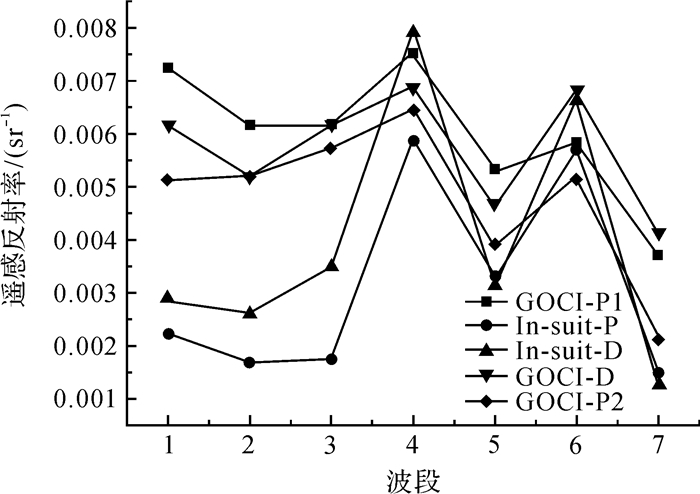
|
图 4 GOCI的赤潮遥感反射率与实测藻类的对比图 Fig. 4 The comparison of remote sensing reflectancebetween GOCI and In-suit GOCI-P1和GOCI-P2分别为2011年05月29日04:28(UTC)和2014年05月23日04:28(UTC)从GOCI上获取的东海原甲藻的均值遥感反射率;In-suit-P和In-suit-D分别为东海原甲藻(Chl-a=42.5 mg·m-3)和中肋骨条藻(Chl-a=41.2 mg·m-3)的遥感反射率[7];GOCI-D为2011年07月28日04:28(UTC)从GOCI上获取的中肋骨条藻的均值遥感反射率. GOCI-P1 and GOCI-P2 are Prorocentrum donghaiense average remote sensing reflectance from GOCI at 04:28 May 29, 2011 (UTC) and 04:28 May 23, 2014(UTC), respectively; In-suit-P and In-suit-D are In-suit Remote Sensing reflectance with Prorocentrum donghaiense(Chl-a=42.5 mg·m-3) and Skeletonema costatum (Chl-a=41.2 mg·m-3), respectively[7]; GOCI-D is Skeletonema costatum average remote sensing reflectance from GOCI at 04:28 July 28, 2011(UTC). |
时间以及藻类数量的不同,可能会造成GOCI反演得到的遥感反射率与实测数据相差甚远.但是不会对判断赤潮事件造成影响.通过与TAO等[7]的遥感反射率归一化(即各个波段的遥感反射率除以第4波段的遥感反射率的比值)比对实测数据和MODIS获取的数据(见图 5).由于MODIS与GOCI的可见光波段范围相近,直接选取相应的波段进行比较.比如MODIS第8波段与GOCI第1波段.通过对比各个波段归一化的遥感反射率值,发现各个赤潮区域的归一化遥感反射率值均符合赤潮提取信息的阀值.
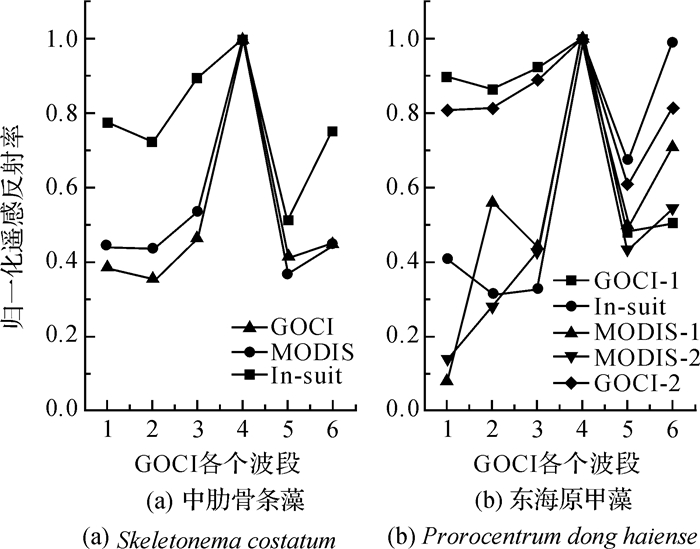
|
图 5 不同藻类的GOCI,MODIS与实测数据等的归一化遥感反射率对比图 Fig. 5 The comparison of GOCI, MODIS and in-suitdata normalized remote sensing reflectance of different algae 其中GOCI,GOCI-1和GOCI-2分别指2011年7月28日,2011年05月29日,2014年05月23日从GOCI上获取的归一化值,其余数据均来自文献[7]. GOCI, GOCI-1 and GOCI-2 are represented GOCI-obtained normalized remote sensing reflectance on July 28, 2011, May 29, 2011, May 23, 2014 respectively, other data come from paper[7]. |
本次赤潮的算法:QUAC进行大气校正,得到水体反射率ρw(λ); 由nLw=ρw×F0(λ)/π,计算nLw; 利用nLw(555)>nLw(λ),nLw(555)<1.5 mW·cm-2·sr-1·μm-1这2个特征参数提取赤潮信息.
本研究根据中国海洋公报2011~2014年公布的赤潮灾害信息,获取我国东海赤潮的时空分布.其中图 6(a)(b)(c)分别为2011年东海原甲藻暴发[6, 13]的02:28,03:28,04:28(UTC,当地时间为10:28,11:28,12:28).而图 6(d)(e)(f)分别为2011年7月28日02:28, 03:28, 04:28(UTC,当地时间为10:28,11:28,12:28).其中图 6(d)(e)(f)中肋骨条藻暴发的时间与公报一致[13].而从图 6(d)(e)(f)中得到该事件面积分别为373,381,1 000 km2.虽然中国海洋灾害公报报道的最大面积为160 km2,但是卫星监测的面积比公报报道的面积大[6],可能是因为公报提供的是单个地方的赤潮信息而非整个区域.

|
图 6 2011年赤潮示意图 Fig. 6 The schematic diagram of red tides in 2011 红色为赤潮区域, 白色为云, 蓝色为正常海域, 黑色为陆地. Red is red tide, white is cloud, blue is ocean, black is land. |
本次赤潮事件的信息主要来源于浙江省海洋公报和中国海洋公报,包括时间范围、地点和最大面积.而本次研究获取的是赤潮的时空分布日变化信息.赤潮提取信息的有效性则利用遥感提取的信息与公报上信息的偏差进行定量分析.偏差值计算公式为
| $ \sigma = \left( {I\left( {{\rm{RS}}} \right) - I\left( {{\rm{GB}}} \right)} \right)/I\left( {{\rm{GB}}} \right), $ |
其中σ为偏差值;I(RS)为利用遥感获取的赤潮信息;I(GB)为公报上的赤潮信息.
具体赤潮提取信息偏差情况,见表 2.
| 表 2 赤潮提取信息的偏差值 Table 2 The bias of extracting red tide information |
由图 7可知,藻类暴发的面积随着时间的推移而变化.从光照强度进行分析,藻类在短时间内暴发可能是受太阳光照和潮位等因素的影响,如图 8所示.早上8:28是赤潮面积最小的时刻[6],并与太湖藻类[24]的生长情况一致.因此,在早上8:00进行赤潮治理可有效控制其面积.赤潮的最大面积出现在10:28与13:28这2个时间点.可能是由于东海原甲藻的最适宜光照条件为38.2+3.8 W·m-2[25],中肋骨条藻的最适宜光照为121.6 W·m-2[26].2014年5月23日中午,赤潮的面积主要受潮位和PAR的影响.MODIS和NOAA等显示,其温度处于适宜范围[27].

|
图 7 2014年05月23日赤潮示意图 Fig. 7 The schematic diagram of red tides on May 23, 2014 红色为赤潮区域,白色为云,蓝色为正常海域,黑色为陆地. Red is red tide, white is cloud, blue is ocean, black is land. |
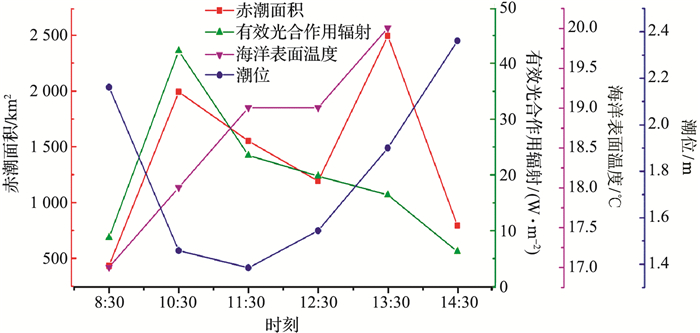
|
图 8 2014年5月23日赤潮面积与有效光合作用辐射、海洋表面温度以及潮位的关系 Fig. 8 The relationship among the red tide and the photosynthetically active radiation, sea surface temperature and the tide level on May 23, 2014 |
在退潮期间,东海原甲藻突然暴发,此现象与文献[6]报道的2011年5月29日和30日赤潮面积增大都是处于退潮期间是一致的.在退潮谷期间,东海原甲藻的光合作用受到抑制并且潮水搅动较少造成底部的营养物质未能被充分带到表层和次表层[6].在10:28,赤潮面积暴涨,而海洋表面的太阳有效辐射量(I0)并非处于最适光照范围,推测此次赤潮事件主要范围可能位于次表层,这与孙百哗等[25]指出的东海原甲藻适宜生存在水深5~15 m处较一致(假设透明度在15 m).而LOU等[6]指出,东海原甲藻叶绿素含量的高值范围随时间变化从0.5 m水深慢慢移动到海洋表面.本次赤潮事件高值区域也可能在水深2 m处,随着时间的推移高值区慢慢向海洋表面移动.
4 结论 4.1本研究算法简单、操作方便,并且对不同藻类的赤潮信息提取均具有良好的结果.利用QUAC获取GOCI的归一化离水辐射率是可行的,尤其对于东海近岸的二类水体.今后,GOCI-QUAC归一化算法可为中国东海近岸水体提供一种环境监测途径.将GOCI-nLw(555 nm)峰值小于1.5 mW·cm-2·sr-1·μm-1作为判断赤潮事件的特征,并以此监测赤潮是可行的.
4.2通过有效光合辐射、温度以及潮位对赤潮的日变化进行定量分析,得到影响赤潮的3个因素。其中影响赤潮面积的主要因素为有效光合辐射和潮位.本次研究为预报和治理赤潮提供了理论基础.
4.3利用GOCI-nLw(555 nm)监测了中国东海不同时间不同区域的3次赤潮事件.今后,可将GOCI作为监测中国东海海洋环境最主要的传感器之一.高时相GOCI水色产品也将为以小时为单位的模型提供基础数据.
感谢韩国卫星中心工作人员Yoon suk和Sun julee提供GOCI、MODIS、AVHRR等数据!感谢AERONET提供Lulin站位的有效光合辐射数据!
| [1] | FEI H. The cause of red tides[J]. Chinese Journal of Science and Art, 1952, 22: 1–3. |
| [2] | CANNIZZARO J P, CARDER K L, CHEN F R, et al. A novel technique for detection of the toxic dinoflagellate, Karenia brevis, in the Gulf of Mexico from remotely sensed ocean color data[J]. Continental Shelf Research, 2008, 28(1): 137–158. DOI:10.1016/j.csr.2004.04.007 |
| [3] | CHOI J K, MIN J E, NOH J H, et al. Harmful algal bloom (HAB) in the East Sea identified by the Geostationary Ocean Color Imager (GOCI)[J]. Harmful Algae, 2014, 39: 295–302. DOI:10.1016/j.hal.2014.08.010 |
| [4] |
孙丽雅, 陈芸芝, 汪小钦. 时间序列MODIS数据赤潮信息提取研究[J].
遥感信息, 2012(3): 71–77.
SUN L Y, CHEN Y Z, WANG X Q. Remote sensing detection of red tide by time-series MODIS date[J]. Remote Sensing Information, 2012(3): 71–77. |
| [5] | SISWANTO E, ISHIZAKA J, TRIPATHY S C, et al. Detection of harmful algal blooms of Karenia mikimotoi using MODIS measurements:A case study of Seto-Inland Sea, Japan[J]. Remote Sensing of Environment, 2013, 129: 185–196. DOI:10.1016/j.rse.2012.11.003 |
| [6] | LOU X, HU C. Diurnal changes of a harmful algal bloom in the East China Sea:Observations from GOCI[J]. Remote Sensing of Environment, 2014, 140: 562–572. DOI:10.1016/j.rse.2013.09.031 |
| [7] | TAO B, MAO Z, LEI H, et al. A novel method for discriminating Prorocentrum donghaiense from diatom blooms in the East China Sea using MODIS measurements[J]. Remote Sensing of Environment, 2015, 158: 267–280. DOI:10.1016/j.rse.2014.11.004 |
| [8] |
丘仲锋, 崔廷伟, 何宜军. 基于水体光谱特性的赤潮分布信息MODIS遥感提取[J].
光谱学与光谱分析, 2011, 31(8): 2233–2237.
QIU Z F, CUI T W, HE Y J. Retrieve of red tide distributions from MODIS date based on the characteristics of water spectrum[J]. Spectroscopy and Spectral Analysis, 2011, 31(8): 2233–2237. |
| [9] | HU C, MULLER-KARGER F E, TAYLOR C J, et al. Red tide detection and tracing using MODIS fluorescence data:A regional example in SW Florida coastal waters[J]. Remote Sensing of Environment, 2005, 97(3): 311–321. DOI:10.1016/j.rse.2005.05.013 |
| [10] |
赵冬至, 张丰收, 杜飞, 等. 不同藻类水体太阳激发的叶绿素荧光峰(SICF)特性研究[J].
遥感学报, 2005, 9(3): 265–270.
ZHAO D Z, ZHANG F S, DU F, et al. Interpretation of sun-induced fluorescence peak of chlorophyll a on reflectance spectrum of algal waters[J]. Journal of Remote Sensing, 2005, 9(3): 265–270. DOI:10.11834/jrs.20050339 |
| [11] |
邢小罡, 赵冬至, 刘玉光, 等. 叶绿素a荧光遥感研究进展[J].
遥感学报, 2007, 11(1): 137–144.
XING X G, ZHAO D Z, LIU Y G, et al. Progress in fluorescence remote sensing of chlorophyllⅡ-a[J]. Journal of Remote Sensing, 2007, 11(1): 137–144. DOI:10.11834/jrs.20070118 |
| [12] | TAO B, MAO Z, PAN D, et al. Influence of bio-optical parameter variability on the reflectance peak position in the red band of algal bloom waters[J]. Ecological Informatics, 2013, 16: 17–24. DOI:10.1016/j.ecoinf.2013.04.005 |
| [13] | LIU L, ZHOU J, ZHENG B, et al. Temporal and spatial distribution of red tide outbreaks in the Yangtze River Estuary and adjacent waters, China[J]. Marine Pollution Bulletin, 2013, 72(1): 213–221. DOI:10.1016/j.marpolbul.2013.04.002 |
| [14] | DAI X, LU D, GUAN W, et al. The correlation between Prorocentrum donghaiense blooms and the Taiwan warm current in the east China Sea-Evidence for the "Pelagic Seed Bank" hypothesis[J]. Chinese Journal of Oceanology and Limnology, 2013, 31(2): 267–281. DOI:10.1007/s00343-013-2150-y |
| [15] | WENG H X, TIAN R X, JI Z Q, et al. Potential relationships between atmospheric particulate matter transported by winter monsoons and red tides in the East China Sea[J]. Chinese Science Bulletin, 2011, 56(3): 297–305. DOI:10.1007/s11434-010-4209-x |
| [16] | ZHANG J, LIU S M, REN J L, et al. Nutrient gradients from the eutrophic Changjiang (Yangtze River) Estuary to the oligotrophic Kuroshio waters and reevaluation of budgets for the East China Sea Shelf[J]. Progress in Oceanography, 2007, 74(4): 449–478. DOI:10.1016/j.pocean.2007.04.019 |
| [17] | BIAN C, JIANG W, QUAN Q, et al. Distributions of suspended sediment concentration in the Yellow Sea and the East China Sea based on field surveys during the four seasons of 2011[J]. Journal of Marine Systems, 2013, 121/122: 24–35. DOI:10.1016/j.jmarsys.2013.03.013 |
| [18] | RYU J H, HAN H J, CHO S, et al. Overview of geostationary ocean color imager (GOCI) and GOCI data processing system (GDPS)[J]. Ocean Science Journal, 2012, 47(3): 223–233. DOI:10.1007/s12601-012-0024-4 |
| [19] |
江彬彬, 张霄宇, 杜泳, 等. 基于GOCI的近岸高浓度悬浮泥沙遥感反演——以杭州湾及邻近海域为例[J].
浙江大学学报:理学版, 2015, 42(2): 220–227.
JIANG B B, ZHANG X Y, DU Y, et al. Retrieving high concentration of suspended sediments based on GOCI:An example of coastal water around Hangzhou Bay, China[J]. Journal of Zhejiang University:Science Edition, 2015, 42(2): 220–227. |
| [20] | BERNSTEIN L S, JIN X, GREGOR B, et al. Quick atmospheric correction code:Algorithm description and recent upgrades[J]. Optical Engineering, 2012, 51(11): 111719. DOI:10.1117/1.OE.51.11.111719 |
| [21] | MENG Q H, MAO Z H, HUANG H Q, et al. Inversion of suspended sediment concentration at the Hangzhou Bay based on the high-resolution satellite HJ-1A/B imagery[C]//Proceedings of SPIE. Remote Sensing and Modeling of Ecosystems for Sustainability X. California:SPIE, 2013:88690W.Doi:10.1117/12.2022698. |
| [22] |
朱兰部, 赵保仁. 渤、黄、东海透明度的分布与变化[J].
海洋湖沼通报, 1991(3): 1–11.
ZHU L B, ZHAO B R. The distribution and change of transparency in the Bohai Sea, the Yellow Sea and the East China Sea[J]. Transaetions of Oceanology and Limnology, 1991(3): 1–11. |
| [23] |
薛宇欢, 熊学军, 刘衍庆. 中国近海海水透明度分布特征与季节变化[J].
海洋科学进展, 2015(1): 38–44.
XUE Y H, XIONG X J, LIU Y Q. Distribution features and seasonal variability of the transparency in offshore waters of China[J]. Advances in Marine Science, 2015(1): 38–44. |
| [24] | LEE Z P, JIANG M, DAVIS C, et al. Impact of multiple satellite ocean color samplings in a day on assessing phytoplankton[J]. Ocean Science Journal, 2012, 47(3): 323–329. DOI:10.1007/s12601-012-0031-5 |
| [25] |
孙百哗, 王修林, 李雁宾, 等. 光照在东海近海东海原甲藻赤潮发生中的作用[J].
环境科学, 2008, 29(2): 362–367.
SUN B H, WANG X L, LI Y B, et al. Effects of irradiance on blooms of the Dinoflagellate Prorocentrum donghaiense Lu in the coastal area in East China Sea[J]. Environmental Science, 2008, 29(2): 362–367. |
| [26] |
孙百晔, 梁生康, 王长友, 等. 光照与东海近海中肋骨条藻(Skeletonema costatum)赤潮发生季节的关系[J].
环境科学, 2008, 29(7): 1849–1954.
SUN B Y, LIANG S K, WANG C Y, et al. Role of irradiance on the seasonality of Skeletonema costatum cleve blooms in the coastal area in east China Sea[J]. Environmental Science, 2008, 29(7): 1849–1954. |
| [27] | XU N, DUAN S, LI A, et al. Effects of temperature, salinity and irradiance on the growth of the harmful dinoflagellate Prorocentrum donghaiense Lu[J]. Harmful Algae, 2010, 9(1): 13–17. DOI:10.1016/j.hal.2009.06.002 |

